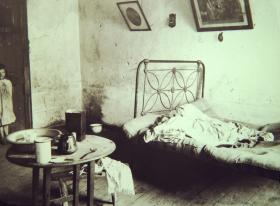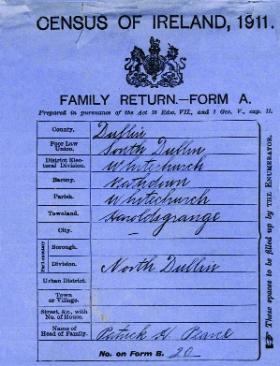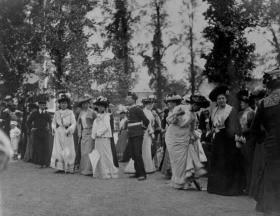Broken down by age, sex and religion: the Irish Census Online Project
Published in 20th Century Social Perspectives, 20th-century / Contemporary History, Features, Issue 3 (May/Jun 2008), Volume 16
A tenement room on Francis Street in 1913. The city of Leopold Bloom and Stephen Dedalus contained fascinating individuals, writers, political activists, artists, soldiers, musicians, tradesmen, and many people living in the worst slums in Europe. (Royal Society of Antiquaries of Ireland)
The census records for 1901 and 1911 have been by far our most popular sources, accounting for 40 per cent of productions to readers. They were the obvious choice for digitisation when we contemplated making some of our holdings available on the internet. Irish census records differ from those of other countries in that the original manuscript returns survive. When you find your great-grandfather’s census return, it will have been filled out and signed by him (if he could write). This provides a direct link to your ancestor, and an element of sympathetic magic. The US, Canada and UK census records comprise only enumerators’ transcriptions; the original returns have been destroyed.
Arrangement
The returns for 1901 and 1911 are arranged by townland (the smallest division of land) or, in urban areas, by street. For every member of each household, the 1901 census lists name, age, sex, relationship to head of the household, religion, occupation, marital status and county or country of birth. The census also records an individual’s ability to read or write and ability to speak the Irish language. All of this information is given on Form A of the census, which was filled in and signed by the head of each household. Where the head of the household could not write, his or her mark, usually an X, was recorded and witnessed by the enumerator. The same information was recorded in the 1911 census, with one significant addition: married women were required to state the number of years they had been married, the number of their children born alive and the number still living.
In addition to returns for every household in the country, both censuses contain returns for police and military barracks, public and private asylums, prisons, hospitals, workhouses, colleges, boarding schools and industrial schools, among other institutions. The returns for both censuses also give details of houses, recording the number of windows, type of roof and number of rooms occupied by each family. Each house is classified according to its overall condition, and the number of out-offices and farm buildings attached to each household is given. This information was recorded by the enumerator, who provided summaries of the returns for each townland and street, including the religious denominations of occupants.
453 John Murphys
Now, for the first time, you can search for your ancestors by name. Up to this, if you didn’t know where your ancestors lived in 1901 or 1911 you had no chance of finding them, as the finding aids were organised topographically, by townland or street, and there was no names index. The census project aims to index every name that appears in both censuses, over 9 million in all between the two census years. The Dublin website allows you, for example, to search for John Murphy, and find that there were 453 John Murphys in Dublin city and county in 1911. You will get a list of them all, with their addresses and ages, and by a process of elimination (age, other family members, occupation, religion etc.) you should be able to identify which of them is your John Murphy.
The site allows you to search by name, surname, age and sex. We would have liked to cover other categories, like occupation and religion, but costs did not permit. When you type a name into the search box, all of the examples of that name appear in a list, with addresses, ages and sex. The list is alphabetically sortable in all categories, and numerically sortable by age. Clicking on any name will bring you a page giving the occupants of that person’s household, and below them you will find the links to the images of the original census forms.

1911 Census return for the household of Patrick Pearse. (National Archives of Ireland)
The site also allows you to browse streets and townlands, looking at all of their inhabitants and at the kinds of houses they lived in. You will find, for example, that Dunville Avenue in Rathmines contained civil servants, clerks and accountants, but also a singing teacher and her two daughters, one of whom was an actress, a cinematograph operator, students and a 68-year-old single woman who said she was of no religious persuasion and refused to divulge any information on the matter to the enumerator.
Many users have reported spending hours browsing their neighbourhoods, and we expect this to be one of the principal uses of the site in schools. You could, for example, create a very rich picture of villages like Malahide, Swords, Monkstown or Clontarf from looking at these returns, which tell you what kinds of buildings existed on the streets, whether shops, public houses, forges, schools, churches, dancehalls, clubs and so on.
One of the most important characteristics of the census website is that it is free. Other countries charge for access to their census records; Ireland has such a fraught archival history that it is our obligation to make what survives freely available in this wonderful new medium. It is greatly to the credit of the Department of Arts, Sport and Tourism that it understands and supports this principle, and that scholars, genealogists and the interested public all over the world can browse freely through the site without incurring huge expense. Four hundred and fifty-three John Murphys would be a much more daunting proposition if you had to pay for every census form image, and many would just give up.
Images
On the Dublin 1911 portion of the site we have provided wonderful illustrative material, essays and photographs on what Dublin was like then. You will be able to look at a tram timetable for 1910, photographs of the royal visit in 1911, James Connolly’s census return from the South Lotts, Lady Gregory and W. B. Yeats in Nolan’s Hotel in South Frederick Street, and the inmates of Mountjoy Prison. In 1911, the 1913 Lockout was two years away, the outbreak of the First World War three years away, and the 1916 Rising five years away, all of them momentous events that would ‘change utterly’ the city and the country.
The Gaelic Revival was in full swing, the Abbey Theatre having been founded in 1904, and interest in the Irish language is evidenced by the many Dublin people who filled out their census form in Irish, often to the dismay of the policemen who had to collect them. Feminists boycotted the census in protest against being denied the vote; there are no returns for Hannah Sheehy-Skeffington, Louie Bennett or Anna Haslam. The city of Leopold Bloom and Stephen Dedalus contained fascinating individuals, writers, political activists, artists, soldiers, musicians, tradesmen, and many people living in the worst slums in Europe. Perhaps the most interesting aspect of these records is the insight they provide into the lives of the ordinary inhabitants of our city.
Our contextual material was provided by Paul Rouse, who researched and wrote the essays and linked them to the census images. Mark Duncan sourced the wonderful collection of photographs provided by our partners in the National Library of Ireland, the Royal Society of Antiquaries of Ireland, and Dublin City Library and Archives, among others.

A well-dressed crowd attends the Great Exhibition, Herbert Park, in 1907. Wonderful illustrative material is provided on the site on what Dublin was like then. (National Library of Ireland)
Future plans
Our plan is to proceed to place the rest of 1911 online this year, starting with Antrim and Down (which cover Belfast) and Kerry, sometime in July 2008. The rest, we hope, will be up by the end of this year, and 1901 by mid-2009. We are focusing on big urban centres because it is much more difficult to find urban ancestors than rural ones. Many people in the last few months have found relatives for the first time, and the site became a popular talking point all over Dublin after the launch and over the Christmas period. It is wonderful to hear people tell the stories that complete and enhance the official record—what happened to the baby who was two in 1911, which great-uncle was killed at the Somme, which great-aunt was a suffragette, what memories survive and what memories are lost.
Catriona Crowe is Senior Archivist at the National Archives of Ireland and coordinator of the Irish Census Online Project.
www.census.nationalarchives.ie
















